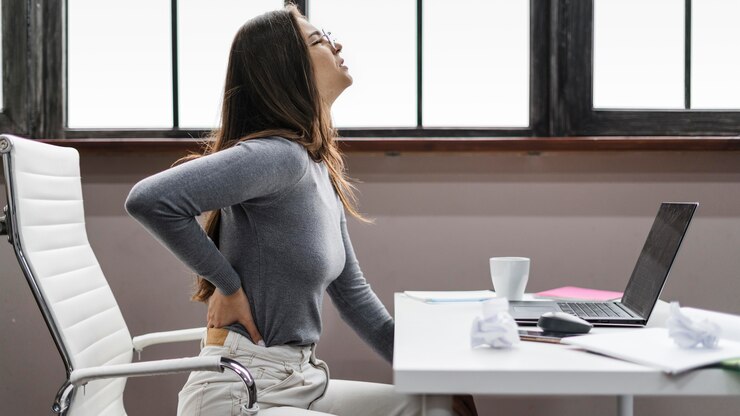
Dealing with lower back pain? You’re definitely not alone—about 80% of people around the world experience back pain at some point in their lives. The pain might feel like a pulled muscle, a sharp stabbing sensation, or even a discomfort that travels down your leg. It can be triggered by things like poor posture, sitting or standing for too long, or even sleeping on the wrong type of mattress. The good news is that, in many cases, you can manage lower back pain right at home with some simple remedies. Let’s break down the common causes and explore ways to ease the pain.
Common Causes of Lower Back Pain
Muscle Strain
Muscle strain is the most common reason for lower back pain. It often happens if you spend too much time sitting, whether at a desk or in a car, or if you stand for long periods. Poor posture can tighten your lower back muscles, making things worse. Throw in heavy lifting, twisting motions, or skipping your warm-up before exercise, and you’re setting yourself up for trouble. Fortunately, this type of pain is usually easy to handle—rest, relaxation, applying ice, and taking anti-inflammatory medications can help you feel better quickly.
Herniated Discs
A herniated or broken disc is a more serious issue. When the outer layer of a disc tears and the inner portion presses on nearby nerves, it can cause anything from mild discomfort to intense pain. In some cases, the pain can radiate down the leg, accompanied by inflammation.
Chronic Conditions
Certain chronic spine issues, like scoliosis, lordosis, or sacroiliac joint dysfunction, can lead to persistent lower back pain. Treatment varies depending on the specific condition, but physical therapy and targeted exercises often provide relief.
Osteoporosis
Osteoporosis, which weakens bones over time, doesn’t usually present symptoms until a fracture occurs. However, it can sometimes cause lower back pain, especially if it affects the hips or the sacroiliac joint.
Osteoarthritis
This inflammatory condition affects joints, including those in the spine, knees, and shoulders. Osteoarthritis pain can range mild to severe depending on how inflamed the affected area is. While the condition progresses over time, certain home remedies can help ease the symptoms.
Home Remedies for Alleviating Lower Back Pain
1. Use Oils or Ointments
Anti-inflammatory oils and ointments are quick solutions that help reduce pain and improve mobility. They’re effective for a wide range of issues, including injuries, osteoarthritis, chronic conditions, and even disc-related pain.
2. Apply a Cold Compress
When dealing with a muscle strain, applying a cold compress is one of the simplest and most effective remedies. It helps reduce inflammation and can speed up recovery when combined with rest.
3. Start a Gentle Exercise Routine
Rest is crucial when pain is at its peak, especially during the first day or two. After that, engaging in gentle, back-friendly exercises can be beneficial. If you’re dealing with a chronic condition, it’s important to stick to movements that won’t worsen your pain. Warm up before exercising, and follow proper techniques suggested by a trainer familiar with back-related issues.
4. Stretch Regularly
Stretching keeps your muscles flexible and reduces stiffness, which can prevent injuries and conditions like bulging discs. Make it a habit to stretch every couple of hours, whether you’re working at a desk or taking a quick break on a long drive. Simple and consistent stretches can go a long way in maintaining spinal health.
5. Try Over-the-Counter Pain Relievers
If compresses, stretching, or ointments aren’t enough, over-the-counter pain relievers can provide additional relief. These medications work by reducing inflammation, which helps manage the pain.
6. Get a Massage
Massaging the painful area can work wonders. Research suggests that massage therapy may not only reduce back pain but also improve spinal function, minimize reliance on painkillers, and speed up recovery.
7. Reduce Stress
Stress, both physical and mental, can take a toll on your back. An Epsom salt bath is great for relaxing tense muscles, while wearing well-fitted shoes can prevent unnecessary strain on your spine. If you’ve tried everything but still experience recurring back pain, it might be time to reassess your footwear.
When to See a Specialist
If your pain lasts for more than a few weeks, becomes so severe that you can’t move easily, or doesn’t improve with natural remedies or over-the-counter treatments, it’s time to consult a doctor. Treatments vary based on the cause—for example, fractures from osteoporosis might require vertebrae cement augmentation, while conditions like sciatica or spinal stenosis can be addressed with steroid injections. For arthritis-related pain, paraspinal joint injections could be recommended.
A spine specialist can identify the exact cause of your pain and suggest the best treatment options. If you’ve reached this point, don’t hesitate to seek professional care to get the relief you need.